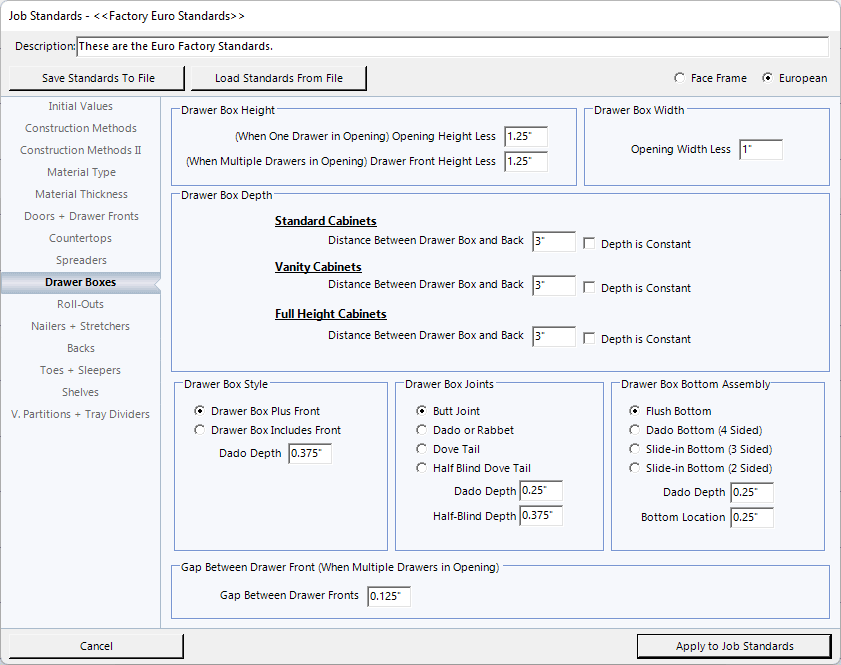Drawer Boxes
Drawer Boxes
In this section, you will enter the different specifications regarding how you build your drawers.

Explanation of Drawer Box Standards
- Drawer Height: Opening Less: Subtract the Drawer Height from the height of the opening. Enter the resulting number. This number will determine the height of the drawer box parts. (Some drawer guide manufacturers list the clearance needed between drawer box and drawer opening. Do not enter the desired drawer height but how much smaller the drawer height is than the opening height.)
- Drawer-Front Height Less: Edit Elevations contains instructions for putting multiple drawers in a single opening. In those cases, Cabinet Solutions needs to know how much smaller than the drawer-front the drawer needs to be. Enter that size here.
- Drawer-Box Width - Opening Less: Subtract the drawer width from the face frame opening width. Enter the resulting number. (This number will depend on the type of hardware you are using and the space you need for the drawer guides.
- Drawer-Box Depth (Standard, Vanity, Full-Height Cabinets):
- Depth is Constant: Check this box if all of your drawers for this type of cabinet are a constant depth.
- Drawer Depth: Enter the depth of your drawers for this type of cabinet if you checked Depth is Constant.
- Cabinet Depth Less: Subtract the drawer depth from the depth of the cabinet. Enter the resulting number. (This number will determine the depth of the drawer and will avoid having drawers that extend to the back of the cabinet.)
- Drawer Box Style:
- Drawer Box plus Front: This style is made up of a four sided box with a bottom. The drawer front is then attached to the box as a sixth piece.
- Drawer Box includes Front: This style is constructed using the actual drawer front as a structural piece of the drawer. The sides and bottom are typically dadoed or dovetailed into the drawer front.
- Drawer Box Joint:
- Butt Joint Drawer Box: This method sandwiches the front and back between the sides without any overlap between them. There are a variety of ways the parts are fastened together including dowels, nails, screws, etc.
- Dado or Rabbet Drawer Box: This method sandwiches the front and back between the sides, overlapping the sides into a groove of some kind (dado, or rabbet) that is cut into the sides.
- Dovetail Drawer Box: This method attaches the box parts together using a full dovetail joint. The front and back of the drawer box extend out to the edge of the overall drawer box and the sides run the full length of the drawer box.
- Half-Blind Dovetail Drawer Box: This method attaches the box parts together using a half-blind dovetail joint. The front and back of the drawer box extend out to the edge of the overall drawer box and the sides run part way into the front and back, being attached using a half-blind dovetail joint.
- Drawer Bottom Assembly:
- Flush Bottom: This assembly method places the bottom of the drawer directly on the bottom of the drawer box front, back, and sides.
- Dado Bottom: This assembly method places the bottom of the drawer inside of the drawer box front, back, and sides. The 4 box parts have dadoes cut in them that the bottom fits into.
- Slide-in Bottom: 3 Sided: This assembly method places the bottom of the drawer inside of the drawer box front and sides, while the back is left short so that the bottom can slide into the groove in the other 3 parts.
- Slide-in Bottom: 2 Sided: This assembly method places the bottom of the drawer inside of the drawer box sides, while the front and back are left short so that the bottom can slide into the groove in the sides.
- Gap Between Drawer-Fronts: Edit Elevations contains instructions for putting multiple drawers in a single opening. To accurately calculate the drawer-front sizes, Cabinet Solutions needs to know what size gap to put between the drawer-fronts.